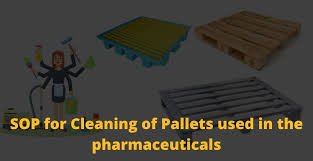SOP for Cleaning of Pallet

Standard Operating Procedure (SOP)
1. Purpose
To define the standard method for cleaning pallets used for material handling and storage to prevent cross-contamination and maintain hygiene in manufacturing and warehouse areas.
2. Scope
This SOP applies to all plastic or wooden pallets used in manufacturing, storage, and transportation of materials within the facility.
3. Responsibilities
-
Warehouse/Production Staff: Perform pallet cleaning as per SOP.
-
Cleaning Personnel: Execute scheduled and unscheduled cleaning.
-
Supervisors: Monitor and verify cleanliness.
-
QA/Compliance: Inspect and approve cleaned pallets, especially for sensitive areas like cleanrooms or sterile zones.
4. Materials and Equipment Required
-
Mild detergent or approved cleaning solution
-
70% Isopropyl Alcohol (for cleanroom pallets if required)
-
Clean water
-
Scrub brushes
-
High-pressure water hose (if applicable)
-
Lint-free cloth or mop
-
PPE (gloves, apron, goggles, mask)
5. Safety Precautions
-
Ensure appropriate PPE is worn during cleaning.
-
Use only approved cleaning agents.
-
Avoid excess water near electrical equipment or in dry zones.
-
Wooden pallets should be checked for splinters or breakage before cleaning.
6. Procedure
6.1 General Instructions
-
Perform cleaning in a designated cleaning area.
-
Separate clean and dirty pallets to avoid cross-contamination.
6.2 Cleaning Steps
For Plastic Pallets:
-
Initial Inspection:
-
Visually inspect the pallet for damage, contamination, or foreign material.
-
-
Dry Cleaning:
-
Remove dust, loose dirt, or debris using a dry brush or cloth.
-
-
Wet Cleaning:
-
Prepare a solution of mild detergent and water.
-
Scrub the pallet using a brush or mop.
-
Focus on corners and contact surfaces.
-
-
Rinsing:
-
Rinse thoroughly with clean water to remove detergent.
-
-
Sanitization (if applicable):
-
Spray with 70% IPA for pallets entering clean or sterile areas.
-
Let it stand for at least 5 minutes before drying.
-
-
Drying:
-
Allow to air dry completely or use a dry, lint-free cloth.
-
-
Final Inspection:
-
Ensure there is no residue, damage, or moisture.
-
Move cleaned pallets to designated “Clean Pallet Area.”
-
For Wooden Pallets:
-
Use minimal moisture to avoid wood degradation.
-
Perform manual cleaning with brushes and sanitizing wipes.
-
Replace if contaminated or damaged beyond cleaning.
7. Cleaning Frequency
-
Routine Cleaning: Weekly or as per area requirements.
-
After Spillages or Contamination: Immediately.
-
Before Entry into Clean Areas: Mandatory sanitization.
8. Documentation
-
Record pallet cleaning in the Pallet Cleaning Logbook.
-
Include date, pallet type, cleaning method, operator initials, and supervisor verification.
9. Abbreviations
-
SOP – Standard Operating Procedure
-
PPE – Personal Protective Equipment
-
IPA – Isopropyl Alcohol
-
QA – Quality Assurance
10. References
-
GMP Guidelines
-
Warehouse Hygiene SOPs
-
Cleaning Agent Safety Data Sheets
🎓 Discover one of the best Pharmaceutical Production courses available — click below to explore the course that’s shaping future Production skills.

